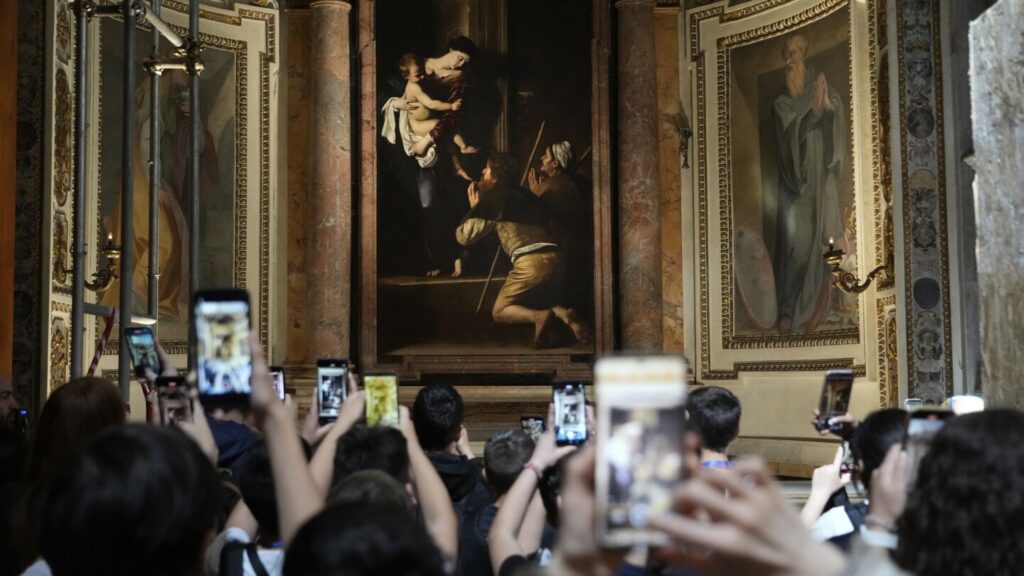ROME (AP) — The Roman basilica of the Augustinians — Pope Leo XIV’s religious order — preserves an iconic painting of the Virgin Mary by Caravaggio, the blockbuster artist who revolutionized the use of light and darkness in Western art.
A new exhibit of works by the Baroque painter is now on view in Rome until July 6, allowing for an updated look at his connection with spirituality.
From the Pilgrims’ Madonna at the Basilica of St. Augustine to the Martyrdom of St. Ursula that closes the “Caravaggio 2025” exhibit, art historians and clergy are highlighting the connections between religious belief and Caravaggio’s “chiaroscuro.”
“It’s the light that directs us toward what for him are the key points of the story,” exhibit curator Francesca Cappelletti said about the artist’s spotlight on the main characters that emerge from encroaching darkness. “Our life experience makes sense only if invested by a spiritual light.”
The Caravaggio Madonna at the Augustinians’ Basilica
In the Augustinian Madonna, dating from the early 1600s, what hits the viewer at eye level are the dirty soles of a ragged pilgrim couple’s feet as they kneel by the apparition of the Virgin Mary. She leans casually against a door frame as she holds a toddler-size Jesus.
It’s a far cry from the usual otherworldly, genteel depictions of most Madonnas. That makes it even more poignant within Augustinian spirituality, because it illustrates the encounter between man’s nature and God’s mercy, said the Rev. Pasquale Cormio, the basilica’s rector.
“We see God’s wish to show himself to humankind as someone who walks alongside the poor,” Cormio said. “It’s certain that this Virgin Mary is close to a perhaps tired, perhaps wounded, certainly dirty humanity that is burdened by daily life.”
The name of the Pilgrims’ Madonna references not only the two figures before Mary, but also the fact that on this spot, the Augustinians have welcomed pilgrims en route to the nearby Vatican since the end of the 13th century.
It was to commemorate a pilgrimage to Loreto — a shrine in central Italy where tradition says Mary’s house was miraculously airlifted — that the painting’s well-connected patrons commissioned it, said Alessandro Zuccari. A member of Italy’s prestigious Accademia dei Lincei, he wrote the chapter on spirituality in the Caravaggio exhibit catalog.
The spirituality of a rebel artist
In fact, despite his adventurous life and bluntly realistic art, Caravaggio worked for prestigious, pious patrons, including a cardinal, and is documented to have participated in Catholic rites including Eucharistic adoration, Zuccari added.
That hardly fits the reputation for a transgressive “accursed artist” that Caravaggio — whose full name was Michelangelo Merisi — accrued over the centuries.
“We don’t know what Caravaggio thought, because he left no writings,” Zuccari said. “I’m convinced, as are other experts, that Caravaggio has his own spirituality.”
Out of about 70 paintings by Caravaggio, more than 50 represent saints or Biblical scenes — even those destined for private collections, not churches, he added.
Religious themes across Caravaggio’s work at new exhibit
Some of the best-known are among the two dozen paintings on view at Palazzo Barberini, covering the time from Caravaggio’s arrival in Rome around 1595 to his death in 1610. They include works on loan from Dublin to Kansas City.
There’s Caravaggio’s first religious painting, St. Francis of Assisi, who’s depicted in an angel’s arms while one of his early companions, Brother Leo, is barely visible in the surrounding darkness.
It’s an early example of those “oscuri gagliardi” — a bold darkness, as a 17th century art critic quoted in an exhibit panel put it. “Gagliardo” is a slang word Romans still use today to mean everything from panini to people with a special flair and power.
Two other religious paintings with the same innovative use of light and darkness take a gruesome turn. In Judith Beheading Holofernes, the Jewish hero frowns in seeming disgust at the blood spurting from his neck. In David with the Head of Goliath, the dripping severed head is a self-portrait.
In what’s probably the artist’s last painting before dying at age 39, and the last exhibited in the new show, Caravaggio also portrayed himself. He’s the man peeking, stunned and openmouthed, from the darkness at the soldier who’s just shot an arrow into St. Ursula’s chest.
More of Caravaggio’s religious paintings are in chapels downtown Rome. The Conversion of Saul, an early version of which is in the exhibit, and the Crucifixion of Peter are in Santa Maria del Popolo, also an Augustinian community. Three paintings about St. Matthew are in San Luigi dei Francesi church.
Two blocks away, back at St. Augustine’s, pilgrims and tourists continue to flock to see Caravaggio and other artwork. For Cormio, welcoming them is a chance to encourage Augustinian spirituality.
“Augustine also left us this teaching — that through the beauty of creation and the beauty of human works, too, we can capture something of the beauty of God,” he said.
___
Associated Press religion coverage receives support through the AP’s collaboration with The Conversation US, with funding from Lilly Endowment Inc. The AP is solely responsible for this content.

